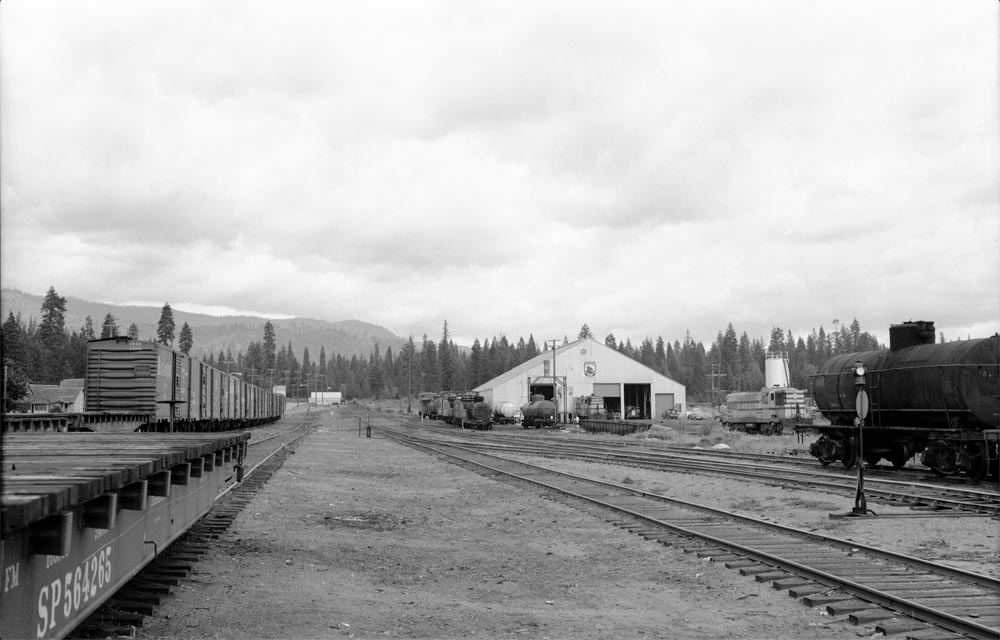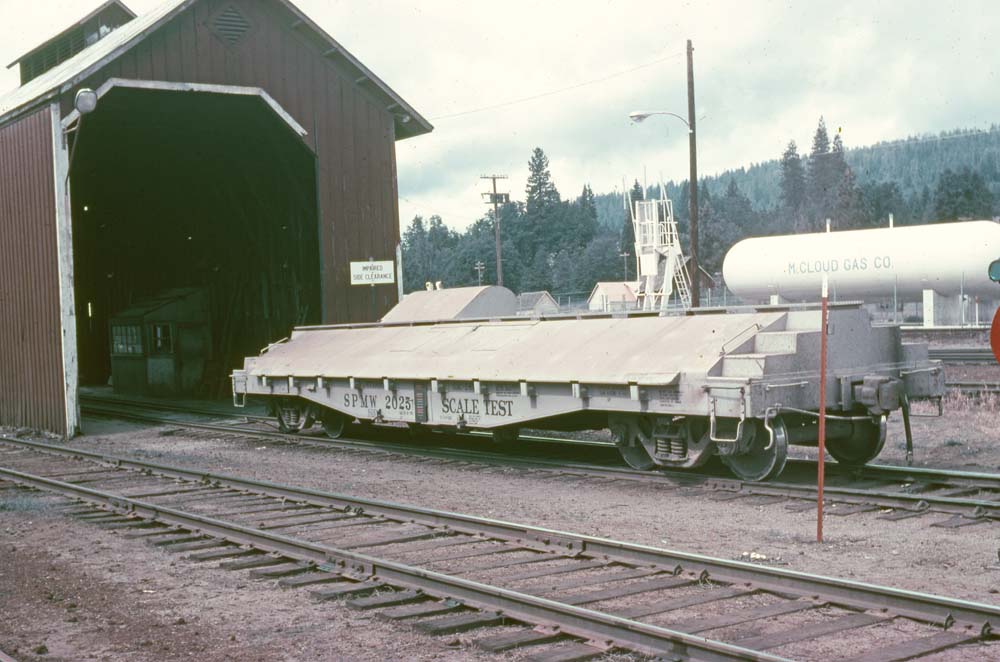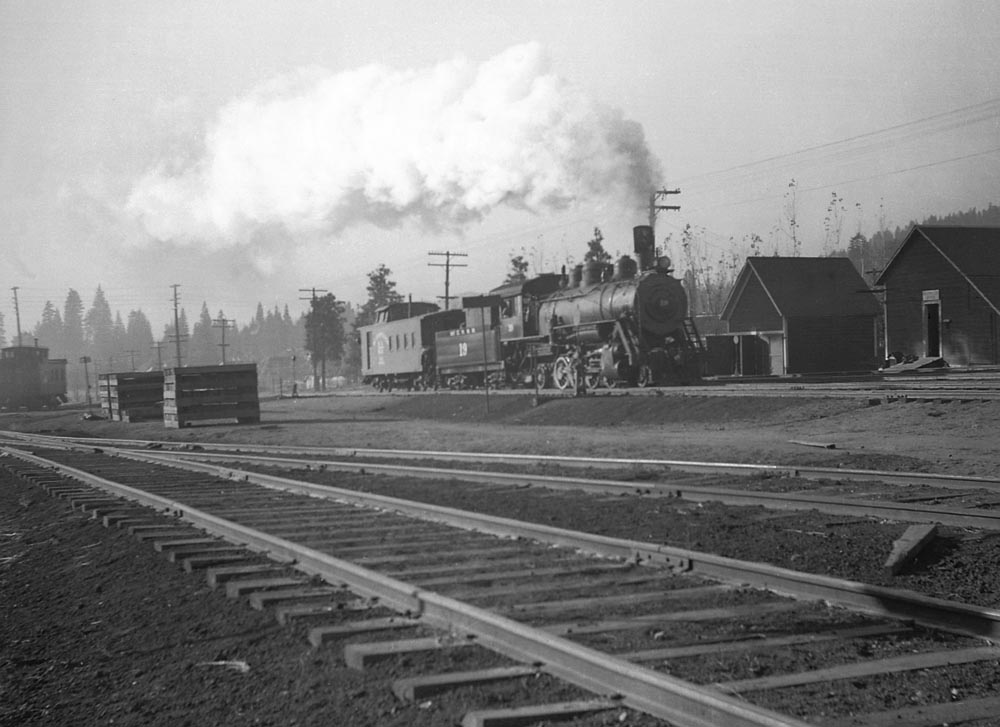|
Along the Line:
McCloud Yards, Scale Houses, and Section Sheds |
|||||||||||||||||||||||||
|
|
|||||||||||||||||||||||||
 |
|||||||||||||||||||||||||
|
The railroad commenced building what would become the McCloud yard just after 1900. The yard grew to contain five sidings off the west side of the
main line, plus one siding and several house tracks and spurs to company facilities on the east side of the main track. The north end of the yard is full of Great Northern boxcars in this image from the 1930s. T.E. Glover. |
|||||||||||||||||||||||||
 |
|||||||||||||||||||||||||
|
A good overview of the yard from near the north end in 1969. #32 and #29 are putting together a train. C.G. Heimerdinger Jr. photo, Jeff
Moore collection. |
|||||||||||||||||||||||||
 |
|||||||||||||||||||||||||
|
The view looking north from about the mid point of the yard in the 1960s. Pacific Northwest Virtual Logging Data Center. |
|||||||||||||||||||||||||
 |
|||||||||||||||||||||||||
|
The lower end of the yard around the middle 1960s. The building at left is the scale house, which contained the track scale used to
weigh cars prior to interchange. Both dated from 1907. The car storage building is in the center, and the track to its right once led to the machine shop and then through the roundhouse to the turntable. House
tracks are to the right, and the car shop is just visible on the extreme right. Pacific Northwest Virtual Logging Data Center. |
|||||||||||||||||||||||||
 |
|||||||||||||||||||||||||
|
The McCloud railroads never owned a scale test car, which forced the company to lease one from Southern Pacific anytime the scales needed to
be checked or calibrated. One such leased scale test car is parked next to the original scale and house in the late 1960s. Lee F. Hower. |
|||||||||||||||||||||||||
|
|
|||||||||||||||||||||||||
|
Several hand fabricated parts of the 1907-built track scale broke around 1970, and with replacement parts unavailable the railroad was unable
to weigh outbound loaded cars. Southern Pacific assessed the railroad $55 per unweighed car delivered to the interchange, which gave the company powerful incentives to replace the scale. The new weigh in motion track
scale, the first such scale installed on a shortline in the United States, prompted a partial rebuild of the yard. The railroad placed the scale on top of a new small hill created just southeast of the shop and built
a new two-track yard on the east side of the building. Outbound loads would typically be pushed across the scale from the south end, with the two yard tracks used to sort BN/WP and SP loads. |
|||||||||||||||||||||||||
 |
|||||||||||||||||||||||||
|
The new track scale and scale house in the early 1980s. Pat Driscoll photo, Jeff Moore collection. |
|||||||||||||||||||||||||
 |
|||||||||||||||||||||||||
|
A close up shot of the track scale. Pat Driscoll photo, Jeff Moore collection. |
|||||||||||||||||||||||||
 |
|||||||||||||||||||||||||
|
The inside of the scale house. Pat Driscoll photo, Jeff Moore collection. |
|||||||||||||||||||||||||
 |
|||||||||||||||||||||||||
|
A brakeman watching loaded lumber cars roll across the scale. Pat Driscoll photo, Jeff Moore collection. |
|||||||||||||||||||||||||
 |
|||||||||||||||||||||||||
|
Another employee at work weighing the outbound loads. Pat Driscoll photo, Jeff Moore collection. |
|||||||||||||||||||||||||
|
|
|||||||||||||||||||||||||
 |
|||||||||||||||||||||||||
|
#39 leading an outbound Lookout Job out of the makeup yard about 1990. C.G. Heimerdinger Jr. photo, Jeff Moore collection. |
|||||||||||||||||||||||||
 |
|||||||||||||||||||||||||
|
#38 shoves on the rear of the same train. C.G. Heimerdinger Jr. photo, Jeff Moore collection. |
|||||||||||||||||||||||||
 |
|||||||||||||||||||||||||
|
#37 leads the third to last revenue freight from Burney into the makeup yard in June 2006. Jeff Moore photo. |
|||||||||||||||||||||||||
|
|
|||||||||||||||||||||||||
 |
|||||||||||||||||||||||||
|
The original section sheds in McCloud lay on the west side of the tracks near the south end of the yard in the general area later occupied
by McCloud Gas Company. The railroad replaced these facilities with new sheds built on the north end of the yard by the later 1960s. Jeff Moore collection. |
|||||||||||||||||||||||||
 |
|||||||||||||||||||||||||
|
Section shed in the yard in the middle 1980s. Drew Toner photo. |
|||||||||||||||||||||||||
 |
|||||||||||||||||||||||||
|
The same shed at the one next to it in 2007. Jeff Moore. |
|||||||||||||||||||||||||
 |
|||||||||||||||||||||||||
|
One of the two smaller sheds across the tracks from the larger sheds. Jeff Moore. |
|||||||||||||||||||||||||
 |
|||||||||||||||||||||||||
|
The other of the smaller section sheds. Jeff Moore. |
|||||||||||||||||||||||||
|
|
|||||||||||||||||||||||||
 |
|||||||||||||||||||||||||
|
The McCloud railroads had a long history of using carbodies as sheds especially around the shop. A wreck damaged boxcars formerly leased to the
Seattle & North Coast is seen here housing the steps used to load passengers in some of the early 1980 excursions. Pat Driscoll photo, Jeff Moore collection. |
|||||||||||||||||||||||||
 |
|||||||||||||||||||||||||
|
When McCloud Railway scrapped the remaining boxcars converted from the all-door cars it retained a number of them for use as sheds
around the property. Jeff Moore. |
|||||||||||||||||||||||||
 |
|||||||||||||||||||||||||
|
Two of the all door carbodies behind the shop. Jeff Moore. |
|||||||||||||||||||||||||
|
|
|||||||||||||||||||||||||
|
|||||||||||||||||||||||||
|
|
|||||||||||||||||||||||||